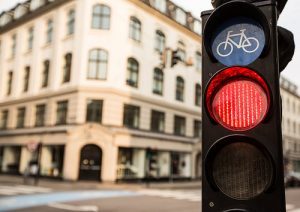Roads were built for cars
This one’s reasonably easy to dispose of when you consider that many of our roads were first built in Roman times. A comprehensive rebuttal exists in the form of Roads Were Not Built For Cars, an exhaustively researched book which uncovers the extent to which cyclists were, in fact, instrumental in pushing for the construction of good quality roads.
Cyclists don’t pay road tax
True. But then no-one’s paid road tax since it was abolished in 1937. Roads are paid for through general local and national taxation. The additional tax burden on motorists is in the form of petrol duty and vehicle excise duty. Lots of cyclists do pay these taxes by the simple fact that being a cyclist and owning a car are not mutually exclusive.
Cyclists should always ride as far to the left as possible
This erroneous and unhelpful belief is perhaps partly a product of the previous two myths, encouraging a view that cyclists are somehow a second class of vehicle on the roads, and should concede space wherever possible. Riding close to the gutter decreases a cyclist’s visibility to other road users, and can encourage drivers to pass in an unsafe way. And when riding past parked cars, it’s always good practice to keep a distance of just over the width of a car door so that, in the event of one opening suddenly, you don’t need to swerve out or, worse still, collide with it. Cycle training can help you to gain a proper understanding of where to position your bike on the road.
A majority of cyclists ignore red lights
The focus of much ire directed at cyclists is generated by red light jumping, or other behaviour that contravenes traffic laws. TFL conducted a fairly comprehensive study into cycling in London in order to test the anecdotal claim that a majority of cyclists ignore red lights, and found that the actual figure was around 16%.
According to the Department for Transport, disobeying traffic signals was a contributory factor in 1% of cycle accidents and 1% of car accidents in 2013. That’s 187 and 1,664 accidents respectively, so while the proportions may be equal, there are many more drivers than cyclists causing accidents by running red lights.
Cycling is dangerous
There are risks associated with all activities, but broadly speaking cycling is not particularly risky. When comparing modes of transport, the relative risks of cycling, walking and driving are fairly similar per hour spent traveling (as opposed to per mile covered). Cycling as a sport carries less risk of injury than alternatives such as football, athletics or even swimming.
Once you balance the risks against the benefits of cycling there is a clear positive net effect on health at both an individual and population-wide level.
You need to be fit
Like any physical activity, cycling can be adjusted to suit all fitness levels and abilities. It can provide really daunting challenges for those looking to push their limits, but it can also be a great starting point for anyone looking to increase levels of activity. Even electric bikes can provide benefits to those otherwise unwilling to get onto two wheels, as we’ve looked at previously on the blog.
Cycling is expensive
It can be, but it doesn’t have to be. Granted, the Tour de France winning Pinarello Dogma F8 won’t leave much change from £10,000, but then you wouldn’t want to leave it locked up outside the pub anyway. A perfectly decent bike can be had for around £300 (or half of that if buying second hand) and although there is a bewildering array of clothing and accessories available, none of it is really essential, except perhaps a good quality lock.
So what’s stopping you?
Leave a Reply